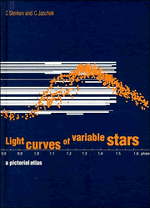Book contents
- Frontmatter
- Contents
- List of contributors
- Preface
- Acknowledgements
- Journal abbreviations
- Acronyms and abbreviations
- 1 Introduction
- 2 Eruptive variables
- 3 Pulsating variables
- 4 Rotating variables
- 5 Cataclysmic (explosive and nova-like) variables
- 6 Eclipsing binary systems
- 7 X-Ray binaries
- References
- Addresses of interest
- Appendix: Tables
- Illustration credits
- Object index
- Subject index
6 - Eclipsing binary systems
Published online by Cambridge University Press: 23 November 2009
- Frontmatter
- Contents
- List of contributors
- Preface
- Acknowledgements
- Journal abbreviations
- Acronyms and abbreviations
- 1 Introduction
- 2 Eruptive variables
- 3 Pulsating variables
- 4 Rotating variables
- 5 Cataclysmic (explosive and nova-like) variables
- 6 Eclipsing binary systems
- 7 X-Ray binaries
- References
- Addresses of interest
- Appendix: Tables
- Illustration credits
- Object index
- Subject index
Summary
Algol type eclipsing binaries
The Algol type eclipsing variables (EA) are a subgroup of the eclipsing binaries segregated according to light curve shape. The light remains rather constant between the eclipses, i.e., variability due to the ellipticity effect and/or the reflection effect is relatively insignificant. Consequently, the moments of the beginning and the end of the eclipses can be determined from the light curve.Eclipses can range from very shallow (0m01) if partial, to very deep (several magnitudes) if total. The two eclipses can be comparable in depth or can be unequal. In a few cases the secondary eclipse is too shallow to be measurable (when one star is very cool), or absent altogether (highly eccentric orbit).
Light curves of this shape are produced by an eclipsing binary in which both components are nearly spherical, or only slightly ellipsoidal in shape. Though not explained in the GCVS, one component may be highly distorted, even filling its Roche lobe, provided it contributes relatively little to the system's total light. This is, in fact, the case for at least half of the known EA variables.
Among the EAs one may find binaries of very different evolutionary status:
(i) binaries containing two main-sequence stars of any spectral type from O to M, with CM Lac an example
(ii) binaries in which one or both components are evolved but have not yet overflowed their Roche lobes, with AR Lac an example
(iii) binaries in which one star unevolved and the other overflowing its Roche lobe and causing mass transfer, with RZ Cas an example
[…]
- Type
- Chapter
- Information
- Light Curves of Variable StarsA Pictorial Atlas, pp. 168 - 187Publisher: Cambridge University PressPrint publication year: 1996



